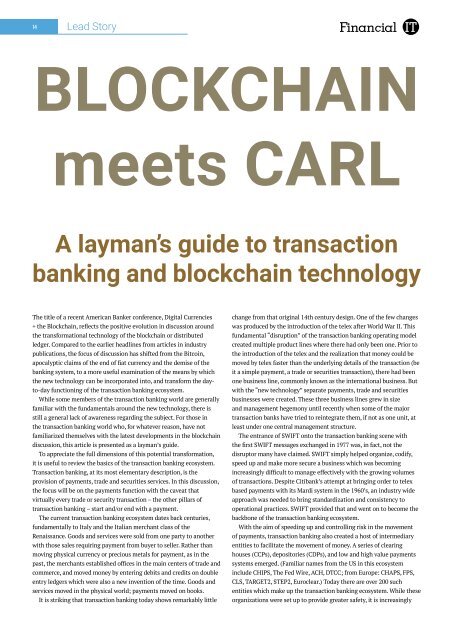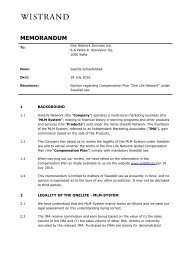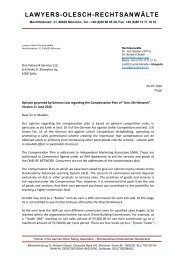Revolutionizing the Financial Markets
With more than 100 000 subscribers of which 70% are banks, Financial IT is focused on publishing news about the leading financial technologies in the world, including the blockchain technology and cryptocurrencies. The February issue of the magazine dedicates its cover to the Founder and CEO of OneCoin, Dr. Ruja Ignatova, and with a 2 pages article sharing OneCoin's story & vision to the world. As Financial IT continies to follow the developments in the company, we are pleased to be recognized as one of the major cryptocurrencies and a key player that shapes the future of payments.
With more than 100 000 subscribers of which 70% are banks, Financial IT is focused on publishing news about the leading financial technologies in the world, including the blockchain technology and cryptocurrencies.
The February issue of the magazine dedicates its cover to the Founder and CEO of OneCoin, Dr. Ruja Ignatova, and with a 2 pages article sharing OneCoin's story & vision to the world. As Financial IT continies to follow the developments in the company, we are pleased to be recognized as one of the major cryptocurrencies and a key player that shapes the future of payments.
You also want an ePaper? Increase the reach of your titles
YUMPU automatically turns print PDFs into web optimized ePapers that Google loves.
14<br />
Lead Story<br />
BLOCKCHAIN<br />
meets CARL<br />
A layman’s guide to transaction<br />
banking and blockchain technology<br />
The title of a recent American Banker conference, Digital Currencies<br />
+ <strong>the</strong> Blockchain, reflects <strong>the</strong> positive evolution in discussion around<br />
<strong>the</strong> transformational technology of <strong>the</strong> blockchain or distributed<br />
ledger. Compared to <strong>the</strong> earlier headlines from articles in industry<br />
publications, <strong>the</strong> focus of discussion has shifted from <strong>the</strong> Bitcoin,<br />
apocalyptic claims of <strong>the</strong> end of fiat currency and <strong>the</strong> demise of <strong>the</strong><br />
banking system, to a more useful examination of <strong>the</strong> means by which<br />
<strong>the</strong> new technology can be incorporated into, and transform <strong>the</strong> dayto-day<br />
functioning of <strong>the</strong> transaction banking ecosystem.<br />
While some members of <strong>the</strong> transaction banking world are generally<br />
familiar with <strong>the</strong> fundamentals around <strong>the</strong> new technology, <strong>the</strong>re is<br />
still a general lack of awareness regarding <strong>the</strong> subject. For those in<br />
<strong>the</strong> transaction banking world who, for whatever reason, have not<br />
familiarized <strong>the</strong>mselves with <strong>the</strong> latest developments in <strong>the</strong> blockchain<br />
discussion, this article is presented as a layman’s guide.<br />
To appreciate <strong>the</strong> full dimensions of this potential transformation,<br />
it is useful to review <strong>the</strong> basics of <strong>the</strong> transaction banking ecosystem.<br />
Transaction banking, at its most elementary description, is <strong>the</strong><br />
provision of payments, trade and securities services. In this discussion,<br />
<strong>the</strong> focus will be on <strong>the</strong> payments function with <strong>the</strong> caveat that<br />
virtually every trade or security transaction – <strong>the</strong> o<strong>the</strong>r pillars of<br />
transaction banking – start and/or end with a payment.<br />
The current transaction banking ecosystem dates back centuries,<br />
fundamentally to Italy and <strong>the</strong> Italian merchant class of <strong>the</strong><br />
Renaissance. Goods and services were sold from one party to ano<strong>the</strong>r<br />
with those sales requiring payment from buyer to seller. Ra<strong>the</strong>r than<br />
moving physical currency or precious metals for payment, as in <strong>the</strong><br />
past, <strong>the</strong> merchants established offices in <strong>the</strong> main centers of trade and<br />
commerce, and moved money by entering debits and credits on double<br />
entry ledgers which were also a new invention of <strong>the</strong> time. Goods and<br />
services moved in <strong>the</strong> physical world; payments moved on books.<br />
It is striking that transaction banking today shows remarkably little<br />
change from that original 14th century design. One of <strong>the</strong> few changes<br />
was produced by <strong>the</strong> introduction of <strong>the</strong> telex after World War II. This<br />
fundamental “disruption” of <strong>the</strong> transaction banking operating model<br />
created multiple product lines where <strong>the</strong>re had only been one. Prior to<br />
<strong>the</strong> introduction of <strong>the</strong> telex and <strong>the</strong> realization that money could be<br />
moved by telex faster than <strong>the</strong> underlying details of <strong>the</strong> transaction (be<br />
it a simple payment, a trade or securities transaction), <strong>the</strong>re had been<br />
one business line, commonly known as <strong>the</strong> international business. But<br />
with <strong>the</strong> “new technology” separate payments, trade and securities<br />
businesses were created. These three business lines grew in size<br />
and management hegemony until recently when some of <strong>the</strong> major<br />
transaction banks have tried to reintegrate <strong>the</strong>m, if not as one unit, at<br />
least under one central management structure.<br />
The entrance of SWIFT onto <strong>the</strong> transaction banking scene with<br />
<strong>the</strong> first SWIFT messages exchanged in 1977 was, in fact, not <strong>the</strong><br />
disruptor many have claimed. SWIFT simply helped organize, codify,<br />
speed up and make more secure a business which was becoming<br />
increasingly difficult to manage effectively with <strong>the</strong> growing volumes<br />
of transactions. Despite Citibank’s attempt at bringing order to telex<br />
based payments with its Mardi system in <strong>the</strong> 1960’s, an industry wide<br />
approach was needed to bring standardization and consistency to<br />
operational practices. SWIFT provided that and went on to become <strong>the</strong><br />
backbone of <strong>the</strong> transaction banking ecosystem.<br />
With <strong>the</strong> aim of speeding up and controlling risk in <strong>the</strong> movement<br />
of payments, transaction banking also created a host of intermediary<br />
entities to facilitate <strong>the</strong> movement of money. A series of clearing<br />
houses (CCPs), depositories (CDPs), and low and high value payments<br />
systems emerged. (Familiar names from <strong>the</strong> US in this ecosystem<br />
include CHIPS, The Fed Wire, ACH, DTCC; from Europe: CHAPS, FPS,<br />
CLS, TARGET2, STEP2, Euroclear.) Today <strong>the</strong>re are over 200 such<br />
entities which make up <strong>the</strong> transaction banking ecosystem. While <strong>the</strong>se<br />
organizations were set up to provide greater safety, it is increasingly





